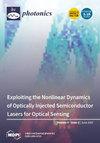Propagation of a Partially Coherent Bessel–Gaussian Beam in a Uniform Medium and Turbulent Atmosphere
IF 2.1
4区 物理与天体物理
Q2 OPTICS
引用次数: 0
Abstract
In this paper, the coherent properties of partially coherent Bessel–Gaussian optical beams propagating through a uniform medium (free space) or a turbulent atmosphere are examined theoretically. The consideration is based on the analytical solution of the equation for the transverse second-order mutual coherence function of the field of partially coherent optical radiation in a turbulent atmosphere. For the partially coherent Bessel–Gaussian beam, the second-order mutual coherence function of the source field is taken as a Gaussian–Schell model. In this approximation, we analyze the behavior of the coherence degree and the integral coherence scale of these beams as a function of the propagation pathlength, propagation conditions, and beam parameters, such as the radius of the Gauss factor of the beam, parameter of the Bessel factor of the beam, topological charge, and correlation width of the source field of partially coherent radiation. It was found that, as a partially coherent vortex Bessel–Gaussian beam propagates through a turbulent atmosphere, there appear not two (as might be expected: one due to atmospheric turbulence and another due to the partial coherence of the source field), but only one ring dislocation of the coherence degree (due to the simultaneous effect of both these factors on the optical radiation). In addition, it is shown that the dislocation of the coherence degree that significantly affects the beam coherence level is formed only for beams, for which the coherence width of the source field is larger than the diameter of the first Fresnel zone.部分相干贝塞尔-高斯光束在均匀介质和湍流大气中的传播
本文从理论上研究了在均匀介质(自由空间)或湍流大气中传播的部分相干贝塞尔-高斯光束的相干特性。研究基于湍流大气中部分相干光辐射场横向二阶互相干函数方程的解析解。对于部分相干贝塞尔-高斯光束,源场的二阶互相干函数被视为高斯-谢尔模型。在此近似条件下,我们分析了这些光束的相干度和积分相干尺度与传播路径长度、传播条件和光束参数(如光束的高斯因子半径、光束的贝塞尔因子参数、拓扑电荷和部分相干辐射源场的相关宽度)的函数关系。研究发现,当部分相干漩涡贝塞尔-高斯光束在湍流大气中传播时,不会出现两个(如预期的那样:一个是由于大气湍流,另一个是由于源场的部分相干),而只会出现一个相干程度的环形错位(由于这两个因素同时对光辐射产生影响)。此外,研究还表明,只有在光束的源场相干宽度大于第一菲涅尔区直径的情况下,才会形成对光束相干水平有显著影响的相干度错位。
本文章由计算机程序翻译,如有差异,请以英文原文为准。
求助全文
约1分钟内获得全文
求助全文
来源期刊

Photonics
Physics and Astronomy-Instrumentation
CiteScore
2.60
自引率
20.80%
发文量
817
审稿时长
8 weeks
期刊介绍:
Photonics (ISSN 2304-6732) aims at a fast turn around time for peer-reviewing manuscripts and producing accepted articles. The online-only and open access nature of the journal will allow for a speedy and wide circulation of your research as well as review articles. We aim at establishing Photonics as a leading venue for publishing high impact fundamental research but also applications of optics and photonics. The journal particularly welcomes both theoretical (simulation) and experimental research. Our aim is to encourage scientists to publish their experimental and theoretical results in as much detail as possible. There is no restriction on the length of the papers. The full experimental details must be provided so that the results can be reproduced. Electronic files and software regarding the full details of the calculation and experimental procedure, if unable to be published in a normal way, can be deposited as supplementary material.
 求助内容:
求助内容: 应助结果提醒方式:
应助结果提醒方式:


